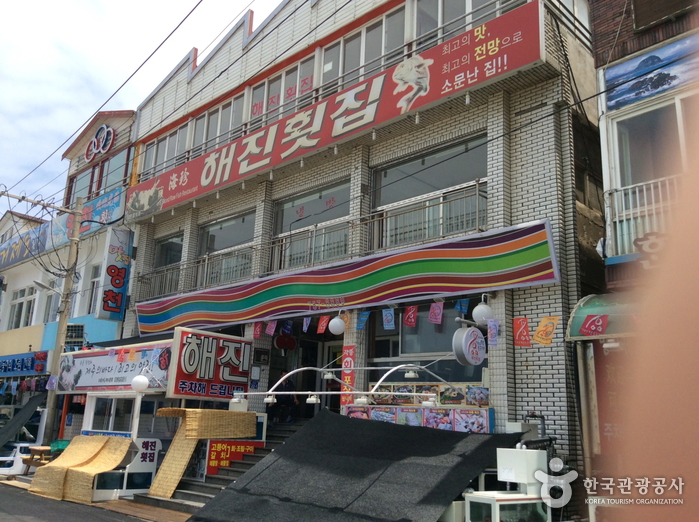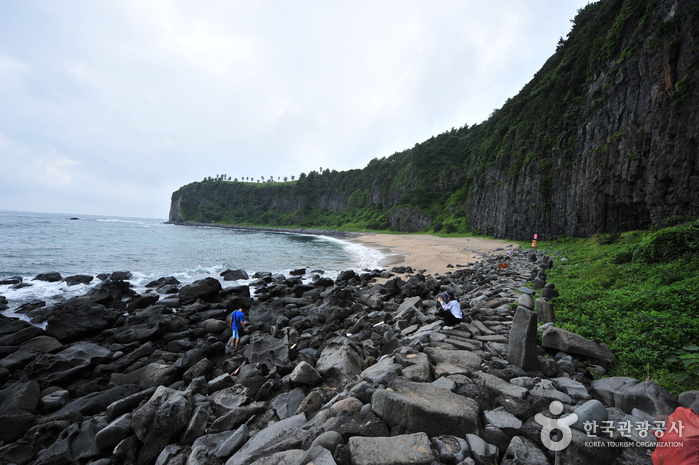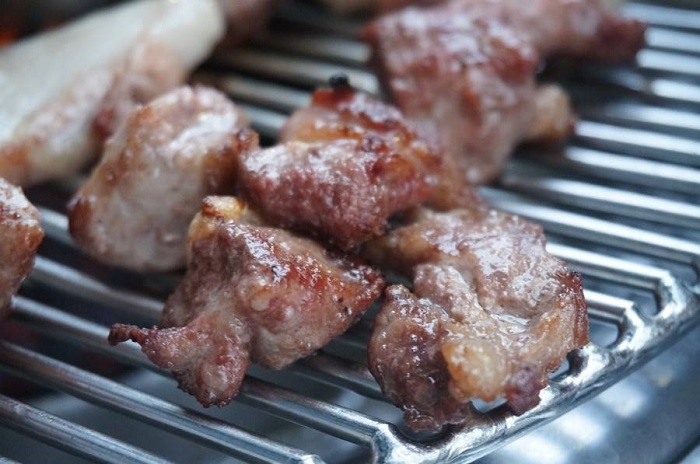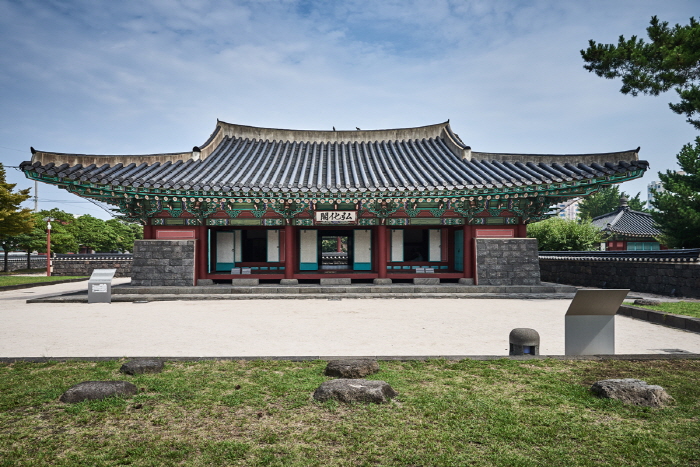Haejin Hoetjip (해진횟집)
12.7Km 2024-03-18
22-1 Seobudu-gil, Jeju-si, Jeju-do
+82-64-722-4584
Haejin Hoetjip is a restaurant located on the breakwater of the western pier at Jeju Port. Its signature dish is gumunjaengi (also known as neungseongeo or sea bass), a delicacy unique to Jeju. In addition to this, the restaurant offers a variety of fresh hoe (sliced raw fish) including chamdom (sea bream) and dageumbari (sawedged perch). Diners on the second and third floors can enjoy views of the Jeju sea. Haejin Hoetjip is a popular spot for both locals and visitors.
Jeju Island Special Tourist Zone (제주도 관광특구)
12.7Km 2025-05-20
Jeju-do
+82-64-740-6000
Located to the southwest of the Korean Peninsula, the island of Jeju is Korea's largest tourist destination. The entire island has been designated as a special tourist zone, and it's easy to see why: there is hardly any spot on the island that is not photogenic. Unlike mainland Korea, which has a temperate climate, Jeju boasts a climate that is closer to subtropical. Hallasan Mountain, lying at the center of the island, is surrounded by 368 parasitic cones, known as "Oreum." Eleven beaches have been designated as tourist beaches, but including those that are not officially designated, the island features nearly thirty beaches in total. Famous beaches include Iho Tewoo Beach, Samyang Beach, Hyeopjae Beach, Geumneung Beach, and Gwakji Beach. Jeju's renowned Olle Trails, a system of hiking paths, span a total length of 425 kilometers and would take about fifteen days to complete in their entirety.
Gwandeokjeong Pavillion (Jeju) [관덕정(제주)]
12.7Km 2024-03-15
19 Gwandeok-ro, Jeju-si, Jeju-do
+82-64-740-6000
One of the oldest buildings in Jeju, Gwandeokjeong Pavilion was established in 1448 by the magistrate of Jeju with the purpose of training local soldiers. This historical edifice is renowend for its intricately painted girders, adorned with murals depicting the ten symbols of longevity, scenes from the Battle of Red Cliffs, and hunting imagery. Additionally, the pavilion's signboard is reputed to feature the handwriting of Prince Anpyeong, a notable figure from the Joseon era. Gwandeokjeong Pavillion is part of the Jeju-mok Government Office complex.
Ujin Haejangguk (우진해장국)
12.7Km 2024-03-27
11 Seosa-ro, Jeju-si, Jeju-do
+82-64-757-3393
Ujin Haejangguk, located near Seomun Sageori (intersection) in Jeju City, specializes in haejangguk (hangover soup). It is so popular that visitors often line up to secure a seat. The restaurant's signature dish is gosari haejangguk (bracken hangover soup), made with bracken and pork. Other favorites on the menu include sagol haejangguk (beef bone hangover soup) and momguk (seaweed soup).
Childonga (칠돈가)
12.7Km 2024-03-18
1 Seocheon-gil, Jeju-si, Jeju-do
+82-64-727-9092
Childonga is a restaurant near the Jeju International Airport, specializing in heukdwaeji gui (grilled black pork). It sources its meat fresh daily to ensure patrons can enjoy the juiciness of the meat. The signature dish is, of course, the heukdwaeji gui (grilled black pork), known for its great texture. Another popular item on the menu is kimchi jjigae. Experts at the restaurant grill the meat for you, so you can enjoy your meat without any worries. Childonga has become a popular dining spot for both locals and tourists.
Jeju Pacific Hotel (제주 퍼시픽 호텔)
12.7Km 2021-03-12
20, Seosa-ro, Jeju-si, Jeju-do
+82-64-758-2500
Jeju Pacific Hotel is located at the center of old Jeju where traditions and history of Jeju Island are well preserved. The hotel is a short distance from Jeju International Airport, making it easily accessible, as well as many popular tourist attractions such as Yongduam Rock and Dongmun Traditional Market.
Jeju-mok Government Office (제주목관아)
12.7Km 2024-03-15
25 Gwandeok-ro, Jeju-si, Jeju-do
+82-64-710-6714
The Jeju-mok Government Office was a gwana, or regional government office, that historically served as the center of Jeju Island’s political, administrative, and cultural activities, spanning from its early days as the State of Tamna through the Joseon period. A significant portion of the structure was destroyed in a fire in 1434, leading to subsequent rebuilding efforts. From 1991, archeological excavations were conducted in four stages, enabling the meticulous restoration of several key buildings within the complex. These include the Honghwagak Pavilion, Yeonhuigak Pavilion, Uyeondang Pavilion, Gyullimdang Pavilion, and Gwandeokjeong Pavillion, all of which were restored by December 2002. Additionally, the complex is known for hosting annual nighttime events.
Hallasan Mountain [National Geopark] (한라산 (제주도 국가지질공원))
12.7Km 2024-12-03
2070-61 1100-ro, Jeju-si, Jeju-do
+82-64-710-3945
Hallasan Mountain stands proudly at the center of Jeju Island and is perhaps the island’s most memorable landmark. Also called Yeongjusan Mountain, meaning "mountain high enough to pull the galaxy," Hallasan Mountain is widely known by scientists for its geological value. Designated as a national park in 1970, there are 368 parasitic cones called "oreum" (Jeju dialect meaning peak) around the main mountain.
Hallasan Mountain is famous for its vertical ecosystem of plants that results from the varying temperatures along the mountainside. Over 1,800 kinds of plants and 4,000 species of animals (3,300 species of insects) have been identified; to explore the mountain's treasures, simply follow one of the well-developed hiking trails.



![NBA [Tax Refund Shop] (엔비에이)](http://tong.visitkorea.or.kr/cms/resource/41/2887441_image2_1.jpg)
![Gwandeokjeong Pavillion (Jeju) [관덕정(제주)]](http://tong.visitkorea.or.kr/cms/resource/75/2513575_image2_1.jpg)


![Hallasan Mountain [National Geopark] (한라산 (제주도 국가지질공원))](http://tong.visitkorea.or.kr/cms/resource/98/2870098_image2_1.jpg)
 English
English
 한국어
한국어 日本語
日本語 中文(简体)
中文(简体) Deutsch
Deutsch Français
Français Español
Español Русский
Русский